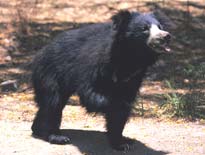The male black bear weighs between 220 and 480 pounds, while the females are110 to 275 pounds in weight. The senses of the Himalayan black bears of India are greatly developed and they boast of almost twice the hearing sensitivity possessed by humans. Black bears have colored vision and their eyesight is very sharp. Even their olfactory senses (ability to smell) are highly evolved. The mating season of the Himalayan black bears is usually from late May to early July. They give birth to two cubs at a time, which stay with the mother for almost seventeen months.
Diet
 Indian black bears are omnivorous. Their diet depends upon the season
as well as the availability of food. The fall season is the time for
having acorns, chestnuts, walnuts, and other fatty food. In spring
season, they survive on a diet of bamboo, raspberry, hydrangea, and
other plants, along with rodent's caches of acorns. Summer season is
perfect for having raspberries, cherries, grasses and ants. Asiatic
black bears are also known to attack livestock at times.
Indian black bears are omnivorous. Their diet depends upon the season
as well as the availability of food. The fall season is the time for
having acorns, chestnuts, walnuts, and other fatty food. In spring
season, they survive on a diet of bamboo, raspberry, hydrangea, and
other plants, along with rodent's caches of acorns. Summer season is
perfect for having raspberries, cherries, grasses and ants. Asiatic
black bears are also known to attack livestock at times.Natural Habitat
Asiatic black bear generally inhabits upper subtropical and lower moist temperate zones. They are found in East Asia and South Asia, including Afghanistan, Pakistan, northern India, Nepal, Sikkim, Bhutan, Burma, southern Siberia, Russia, northeastern China, Taiwan and Japan. In India, Asiatic black bears are found occupying Himalayan foothills, at a height of less than 3,750 m. Black bears are also found in the Arun valley of Nepal, inhabiting Sal-Castanopsis, Castanopsis and Rhododendron forests as well as the forests with bamboo groves.
Status and Threats
Asiatic black bear is listed as endangered on the World Conservation Union's (IUCN's) Red List of Threatened Animals. One of the major reasons that have contributed to the declining population of black bears is rampant deforestation and habitat loss. Asiatic black bears also face threat from farmers, who kill them in order to protect their livestock.


